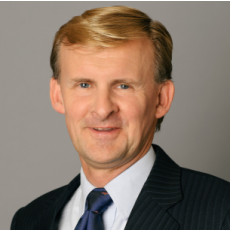Ascot is a Canadian mining company focused on commissioning its 100%-owned Premier Gold Mine, which poured first gold in April 2024 and is located on Nisga’a Nation Treaty Lands, in the Golden Triangle of northwestern British Columbia.
Could you tell us a little about your background and what led you to Ascot Resources?
I am a geological engineer by training. I grew up in Vancouver, Canada, and around the age of 25, I moved abroad. My career took me to various locations, including South Africa, and I worked with a company in London, which later merged with BHP. After working for large multinational companies on big projects, my colleagues and I started a mining company called Quadra Mining in 2004, focusing on copper. Building this company from scratch was a different experience compared to working for huge companies, as it required us to handle every aspect and build our team from the ground up. Despite the hard work, I enjoyed the process immensely.
We eventually sold Quadra Mining to KGHM, as they were interested in our large copper mine project in Chile. In 2017, I was approached to consider a mining opportunity in British Columbia. This project, Ascot Resources, was appealing because of its existing infrastructure, previously owned by a Swedish company, Boliden. They were not interested in gold mining and had left significant infrastructure behind. My colleagues and I saw an opportunity to rapidly retrofit and modernize this abandoned project, which involved updating environmental standards and energy requirements. It was reminiscent of our work in 2004, but with new challenges.
You are referring to your Premier Gold Project. What were the challenges you faced retrofitting it?
The mining industry has faced significant changes over the past 20 years. Around 1998, metal prices, especially for base metals like copper, dropped sharply. Many companies exited the business, and young people pursued careers in the dot-com industry instead of engineering. However, when China industrialized around 2004, demand for base metals surged, benefiting companies in this sector until the financial crisis in 2008. By 2017, a major challenge was the shortage of skilled professionals, as fewer people were entering the industry, and many experienced professionals were nearing retirement.
Additionally, the financial crisis made it difficult to attract new talent, and many people were unwilling to work in remote locations. Another challenge was attracting investment. Generalist investors moved their money to technology stocks, leaving less capital for the mining sector. This trend began before COVID-19 and continued afterward. The pandemic also disrupted the workforce, making it harder to staff remote mine sites. We had to rely on a diverse international workforce, which included professionals from West Africa, Namibia, Peru, and China. The logistical challenges and changes in workforce dynamics due to COVID-19 were significant hurdles.
How did you address the issue of workforce shortages?
To address workforce shortages, we leveraged our network of experienced professionals, many of whom were semi-retired but passionate about the industry and willing to return to work. We also focused on mentoring younger professionals who lacked experience by pairing them with seasoned experts for on-the-job training. This approach helped bridge the gap and ensured knowledge transfer from experienced professionals to the next generation.
Additionally, we recruited internationally, attracting skilled graduates from developing countries who were eager to gain experience in Canada. We implemented a rotational work schedule, offering two weeks on-site followed by two weeks off, which appealed to many workers. This schedule allowed us to attract talent from urban centers like Vancouver. By offering this flexible working arrangement, we were able to maintain a steady workforce even in remote areas. This approach has been essential in ensuring we have the necessary human resources to operate effectively.
What about investment? How did you attract capital during these challenging times?
Attracting investment has been a significant challenge, especially for smaller companies like ours. Typically, in the mining industry, smaller companies rely on a mix of debt and equity financing, with banks usually providing 60% of the capital as debt and the remaining 40% coming from equity. Initially, we worked with a debt provider, but that did not work out well, so we switched to a royalty provider. In Canada, there are several royalty providers willing to finance mining projects. While this approach has its downsides, such as giving up a portion of our upside, it aligned the risk with the streamer and provided us with the necessary capital.
We were also fortunate to attract investment from an influential family in Peru who owns the largest gold mine in the country. Their interest and investment provided a substantial equity injection, which in turn encouraged other retail investors to follow. The combination of these factors, along with a brownfield site with existing infrastructure, allowed us to significantly reduce our capital costs. By retrofitting an existing site rather than starting a greenfield project, we managed to contain costs and secure the necessary funding to move forward, even during challenging times.
Moving on to the present – the Premier Gold mine has poured its first gold in April. What does that mean? When can we expect commercial production?
Generally, when building a mine, there are phases. The first phase is the construction phase, where constructors, not operators, build the mine mechanically and electrically, primarily focusing on the mill and underground development. We are currently in the commissioning phase, which typically lasts three to five months. During this phase, we test the actual process of refining and processing gold. This involves using test ores to troubleshoot and fine-tune the system, gradually increasing the volume processed each day.
We are about halfway through the commissioning process. As we progress, we will start using actual mining ores to ramp up gold production. This phase involves identifying and resolving any issues to ensure the system operates smoothly. We expect to complete commissioning around the third quarter of 2024. After that, we aim to reach a steady state by resolving all problems, leading to commercial production.
What are the next big objectives for Ascot, and what challenges could hinder their achievement?
The capital markets are cautious, especially for juniors. Investors are excited about high gold prices but want to see us successfully navigate the commissioning phase. Successfully getting through this phase reduces risk and increases investor confidence. The biggest challenge is ensuring a smooth commissioning process. If we succeed, investors will perceive us as less risky.
As a small player with a single asset, diversification is crucial. Investors prefer companies with multiple cash flow-producing assets to reduce risk. This often leads to mergers or acquisitions by larger companies. While CEOs may resist losing control, merging or being acquired can benefit shareholders by de-risking the asset and enabling growth. Our strategy will likely involve pursuing additional assets or partnerships to meet investor expectations and ensure sustainable growth.
With interest rates that are about to diminish, do you expect gold prices to continue rising in the coming months?
For metals like gold and silver, there are different driving factors. A significant concern globally is the stability of the U.S. dollar. Although it is the most liquid instrument, there is worry about the U.S.'s significant debt and ongoing issues. As interest rates lower, the attractiveness of the U.S. dollar decreases, pushing investors to seek alternatives. Gold remains a stable and attractive option, with central banks and countries accumulating more gold.
Additionally, we face a shortage of physical metal, which exacerbates the issue. If demand for physical gold increases, we lack enough mines to meet that demand. This is not just a problem for gold but also for other critical metals like copper, which is essential for electrification and reducing carbon reliance. The supply constraints for these metals indicate that their prices will likely remain strong over the next decade.
What do you do to ensure sustainable mining?
We are fortunate to have a hydroelectric dam providing clean power, significantly reducing our greenhouse gas emissions. Being in a mountainous area, our hydroelectric dam near the mill generates clean energy without carbon sources. Additionally, as an underground mine, our energy consumption is lower, giving us a small carbon footprint.
Water treatment is another crucial aspect of our sustainability efforts. We have a large water treatment plant to ensure no contamination of the surrounding environment. Meeting high standards in water control is essential for long-term sustainability. Furthermore, our partnership with the Nisga’a First Nation is a cornerstone of our sustainable practices. Engaging with local communities and ensuring their participation in our operations helps us maintain a positive and sustainable impact.
Where do you hope to see Ascot Resources three years from now?
In three years, I hope we would have made a positive impact on the community of Stewart, BC and Nisga’a Nation, establishing a sustainable long-term mining operation. I also anticipate the possibility that we will have joined forces with another mining company, diversifying our operations to include at least two mines. This would reduce risk and enhance our growth potential. Finally, I hope we would have successfully trained a new generation of professionals. Ensuring that young people are equipped to take over and advance sustainable mining practices is crucial for the future of the industry and the continued success of our operations.





